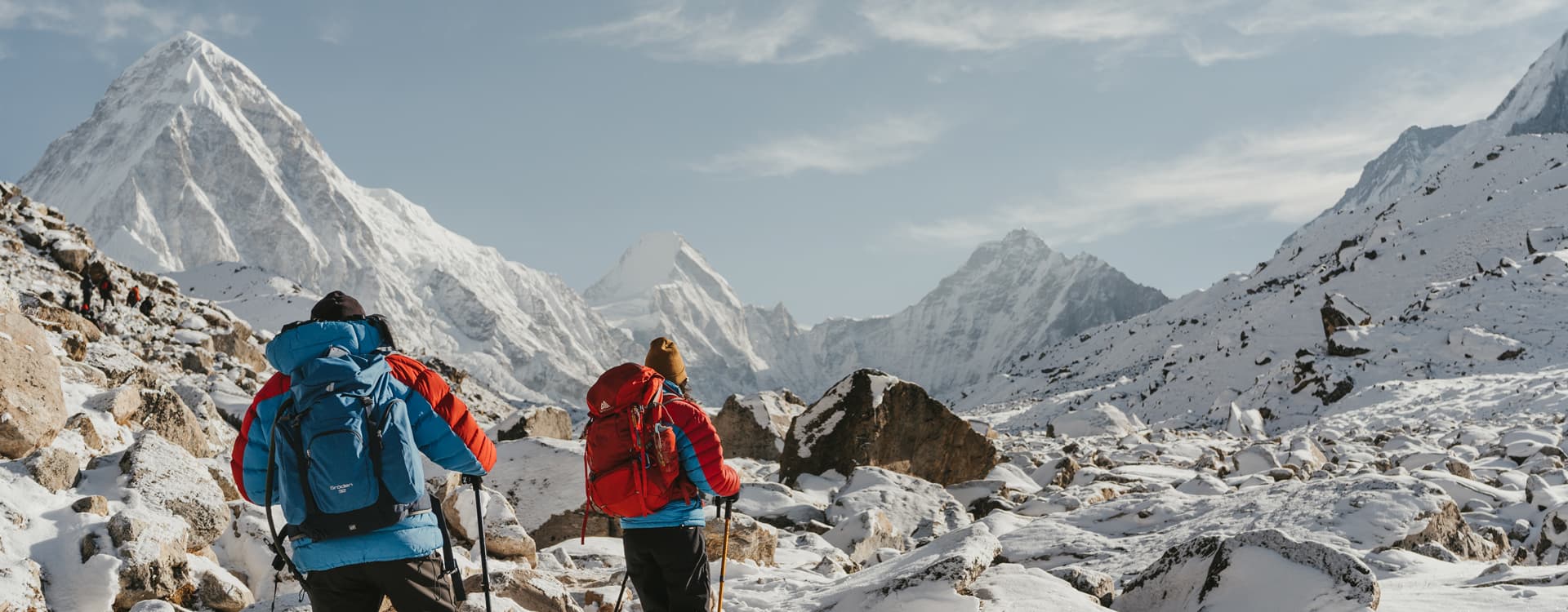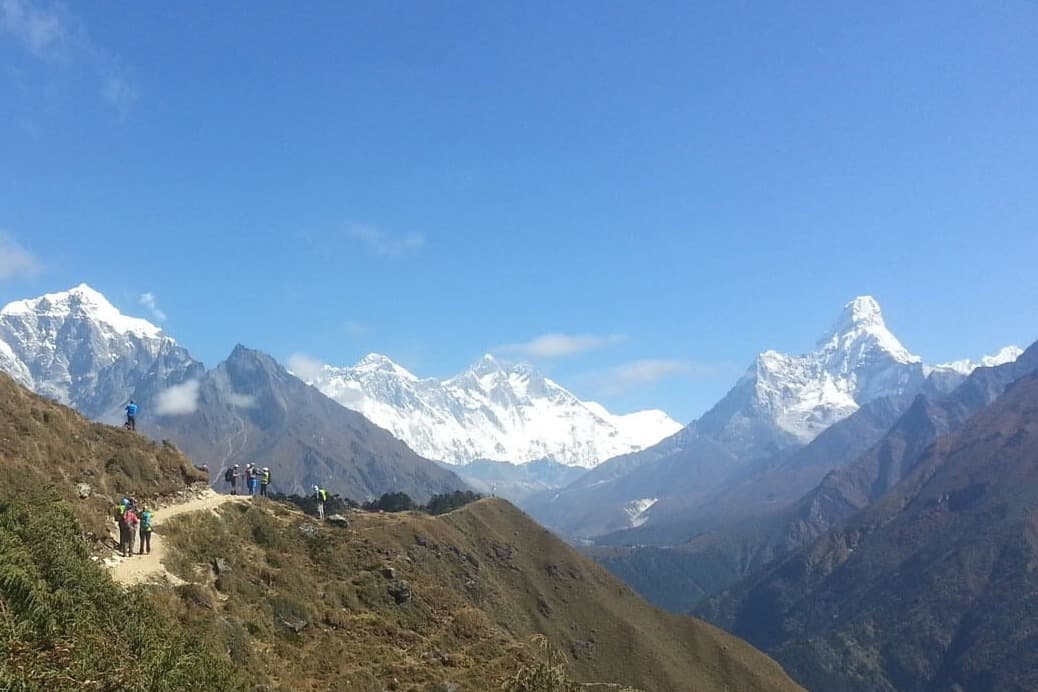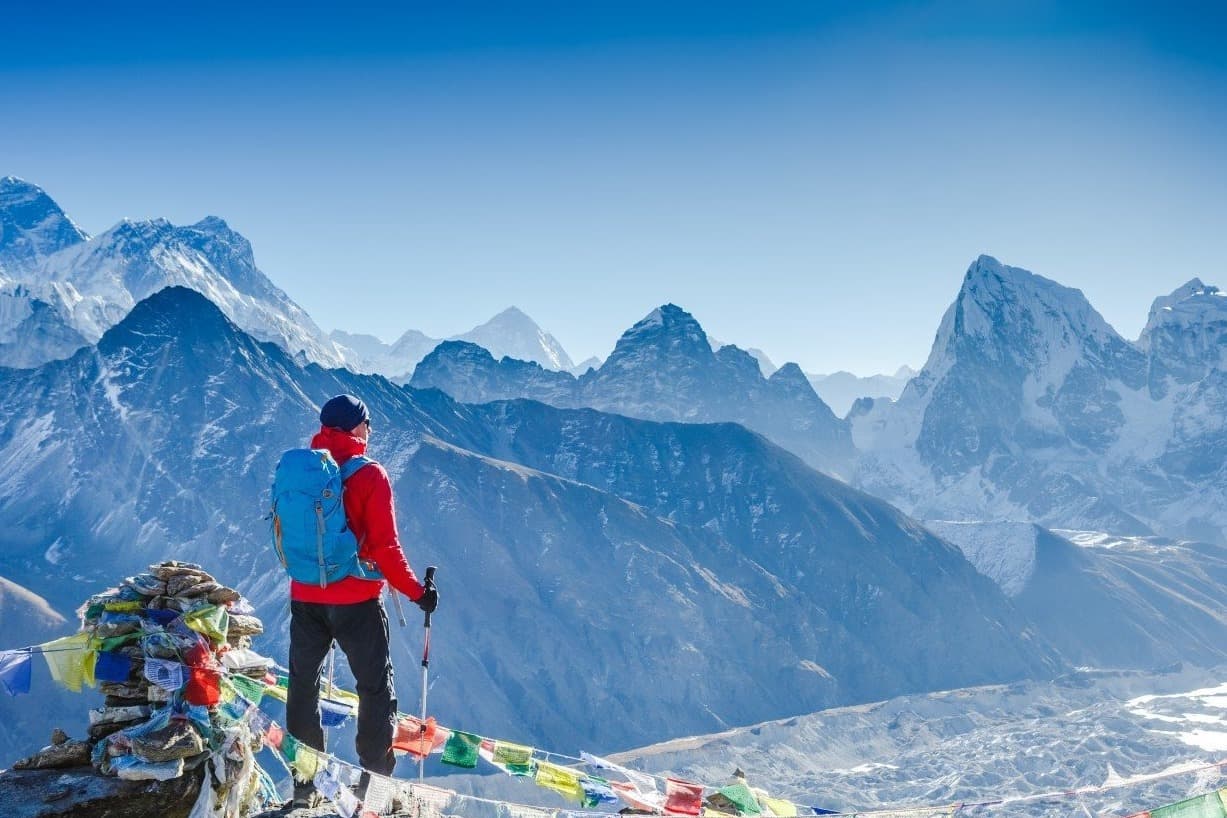When it comes to packing we tend to get really lazy and end up procrastinating until the very last minute. But, if you are planning on going for a trek that too in the Everest region then packing is something that you should be very mindful about.
Trekking to the Everest region is included in many of our bucket lists. Oh, to feel the cool fresh breeze of wind surrounded by the Himalayas. Sounds like an experience of a lifetime doesn’t it?
However, to make your Everest region trek as successful and fun as you imagine it to be, a lot of consideration and carefulness is needed, especially when it comes to packing.
As you start packing for your trek please make sure that you divide your backpacks into two different backpacks. One will be your daypack which you will carry with you the whole day and the other will be a duffle bag which will be carried by porters.
You can leave your extra luggages in your hotel at Kathmandu. Make sure that the daypack which you will be carrying with yourself consists of important things like water bottles, energy bars, some cash, and medicines.
You can keep the rest of your stuff in your duffle bags which will be carried to each of your tea houses by porters.
A Complete Packing List for Everest Region Treks
This is an extensive packing list for Everest Base Camp. It contains clothing to keep you warm in the Himalayan region's unpredictable weather, equipment to make your walk comfortable and easy, and supplies to make sure you have the most memorable experience possible.
We have recommended essential things to pack for your reference. Please feel free to contact us if you have any queries about this packing list or about trekking to Everest region in general.
Clothing
The clothes you bring for your Everest Base Camp trek will mostly depend on the season and the particular trek you intend to do. We offer packing recommendations for the standard trip to Everest region, which involves nearly 3,000-meter elevation gain.
Layering is an essential trekking concept because of the significant differences in temperature caused by changes in altitude. While trekking, having the option to add or remove layers of clothing can help you stay comfortable and safe by allowing you to quickly adjust to changes in temperature.
It is absolutely necessary to carry a little bit warmer clothing if you intend to go trekking in the colder winter months of December through February. Here are some clothing recommendations for you to pack.
Base Layers
The base layer is the initial layer of clothing you put on which is crucial for the treks that are colder and at higher elevations. This implies that you won't likely wear it for the early and end sections of the hike.
When choosing a suitable base layer, the most crucial factors to take into account are the fit and substance.
Insulation Layer
The insulation layer, which is the second layer, is often composed of fleece-like material. They are available for the torso and legs.
Patagonia, Helly Hansen, Columbia, REI, and The North Face are among the well-known designers of fleece jackets.
Outer Layer
This layer, often known as the outer core layer, is made up of warm, waterproof pants and jacket. These will mostly be utilized at the trek's higher elevations or in instances of extremely cold or wet weather.
Trekking Trousers
For the lower or warmer portions of the hike, we advise packing one pair of hiking pants and one pair of hiking shorts. However, make sure to carry extra trekking trousers incase of emergencies.
Trekking T-Shirts
You'll need about five or six shirts that you can wear most of the time. Steer clear of cotton since it retains moisture rather than draining sweat away, which leads to clothes that smell terrible after a few wears.
A breathable, light-weight, and quickly-drying polyester, merino, or nylon fabric is ideal. We advise you to wear both long and short sleeve shirts.
Waterproof Jackets and Trousers
It's always possible to encounter rain on the path, particularly if you want to hike from June to September. We advise you to pack some rain gear as a general precaution, preferably a gore-tex membrane hard shell jacket.
Inner Gloves
When the weather is moderate or you have to do complicated work like tying shoe laces, you can use light inner gloves.
Outer Insulated Gloves
An outer pair of mittens or gloves has to be solid, waterproof, and warm. Unless you want to do any climbing in the area, they don't need to be really well insulated.
However, they should keep your hands warm in below-freezing weather.
Undergarments
In addition, undergarments must be moisture-wicking and breathable, which is why we advise ladies to own two sports bras and five pieces of sports underwear.
Footwear
One of the most crucial items of equipment that you must have correctly is footwear. Considering that your feet are what carry you all the way to the Everest region, you need to make sure your trekking boots are comfy.
Spending a little more money on high-quality boots and socks will prevent your feet from getting swollen and from blistering, which is a nightmare that you do not want to encounter.
Hiking Boots
Size is very crucial when it comes to buying any shoes. Especially if you are buying it for treks that too for the Everest region you need to make sure it fits properly.
To make sure your hiking boots fit properly, you should be able to fit one finger behind your heel. A boot is too big if it has too much room for your finger, and too tiny if there is not enough room.
Look for hiking footwear with water resistance and an ankle support system that is between medium and light in weight. Ensure if the boot has deep cut tread on the sole and that you can easily tie and untie the laces.
Trekking Shoes
It is advised that you trek in boots rather than shoes because they offer significantly more support.
It provides far more ankle support and prevents twisting. After a day of hiking, bring comfortable, light shoes that you can wear inside and around the tea houses.
Trekking Socks
We suggest you avoid purchasing cotton-based hiking socks as they are not moisture-wicking or breathable. The most suggested material for trekking socks is merino wool.
It is highly recommended that you bring at least 5 to 6 pairs of trekking socks with you. In addition to that make sure to add some extra pairs of trekking socks as well in case of emergencies.
Warm Thermal Socks
Thermal socks are used in colder environments, such those found around or at Base Camp. They are a little thicker than regular trekking socks.
We suggest you bring at least 1 to 2 pairs of thermal socks along with you.
Gaiters
The purpose of gaiters is to keep rocks, dirt, water, and other objects out of your boots by covering the ankle-high opening.
Gaiters can be optional if you are planning to trek to the Everest region in the warmer weather.
Backpacks
Whether you will be carrying your own equipment or using a porter will determine what kind of bag you require. We recommend you to carry at least an 80L duffel bag.
In all of your treks to the Everest region we will provide you with porters who will carry all your bags except for the daypack which you will be carrying with yourself.
Duffel Bag
Since porters will be carrying your belongings, a duffel bag is the ideal choice. Your duffle bag has to be solid, water-resistant, and lockable.
Backpack
You'll need a good-quality backpack with an opening at the top. Make sure to pack essentials in your backpack.
Daypack
Even if you have a porter, you will still need a small bag to hold water, rain gear, food, your camera, and other goods you want to have easily accessible while trekking.
Raincover
As weather in Everest can be unpredictable we suggest you to invest in a good quality raincover. Make sure it perfectly covers your backpacks and is water resilient.
Headwear & Headgear
Headwears will protect you from the sun, rain, and cold temperatures. Make sure your headwears are comfortable.
Hat
You'll need a good hiking hat with a broad brim that blocks the sun. We advise you to get those that fit comfortably around your neck, are lightweight, and are simple to pack.
Beanie
When the weather turns chilly at night or as you approach Everest Base Camp, a beanie is a must. Ww recommend buying your beanie from North Face brand.
Neck Gaiter
Another excellent, inexpensive, and priceless item of apparel is a neck warmer or gaiter. Neck gaiters will keep your face and neck warm and help avoid the dreaded Khumbu cough.
Sunglasses
Due to the increased UV strength at altitude and the brightness from snow-covered peaks as you approach EBC, a decent pair of UV-blocking sunglasses are a must. We advise wearing glasses with at least 80% light reduction and 100% UV protection.
Headlight
Since many of the teahouses are dimly lit, it is advisable to include a light for nighttime navigation. Make sure to carry a few extra pairs of batteries for the headlight.
Miscellaneous Accessories
These are some essential accessories that you need to pack for your trek to Everest region.
Water bottle
Proper hydration is essential during the journey since dehydration is a contributing factor to altitude-related illnesses.
Aim for two to three liters of water every day. We recommend water bladders, although you might prefer bottles.
Towel
After washing, a little towel works well for drying yourself. We recommend you to bring towels that are quick to dry.
Camera
A decent camera will be essential to capture and preserve your Himalayan experience. The breathtaking mountain view in the Everest region is simply too magnificent for a smartphone, even with its current high level of performance.
Portable Charger
It is strongly advised that you bring a USB charger if you want to carry anything electronic, such as a phone, camera, or Kindle.
Some tea places feature charging facilities but they will likely demand you pay and dependability isn’t excellent.
Books
There is a lot of spare time, especially in the evening, so you can spend the time and learn more about the Himalayas by reading a book or using an e-reader.
Trekking Poles
Utilizing trekking poles is advised for the majority of hikers since they lessen joint tension and impact.
Medicines & Toiletries
The most important part while packing is for you to make sure to have all of the necessary medications and toiletries.
Water Purification Tablets
Make sure to purify the water before drinking it. Water can be purified in a variety of ways, such as by boiling, using reverse osmosis, or adding iodine tablets.
We advise using water purification pills before consuming water in all situations. These pills for water filtration will work as promised.
First Aid Kit
Even though our guides will carry a set of first aid kits with them make sure to carry basic first aid with yourself as well.
Sunscreen
UV-rated lip balm and sunscreen with at least SPF 30 will shield you from the sun's rays.
Wet wipes and Hand Sanitizer
Bring a supply of baby wipes for easy cleanup and hydration. Bring hand sanitizers as well so you may give your hands a brief wash before dining.
Toiletries
In your basic amenities, we suggest you include two rolls of toilet paper and basic toiletries like toothpaste and a toothbrush. On the route, you can purchase some inexpensive amenities, including toilet paper.
Important Documents
Here is a list of important documents to carry with you during your Everest region Trek.
- Two passport size pictures
- Passport and Nepal’s visa
- Travel Insurance
- Permits
- Cash
Conclusion
This packing list gives you a detailed overview of everything you'll need for your trek to the Everest region. With careful packing you can ensure a smooth and comfortable trek to Everest region.
It's crucial to keep in mind to pack light, wear layers of clothing, acclimate to the altitude, stay hydrated, watch out for altitude sickness, and, above all, enjoy the amazing trek to the base of the tallest Himalayas in the world.




